There is a trend in spaces that are neither indoors, nor are they completely exposed to the elements. But today, home supply stores have dedicated around 350% more space to outdoor living than they did in 1990. This idea of bridging architecture with nature has been adopted by designers wanting to rethink the best use of a property’s footprint. The trend reminds me of one particularly vivid memory from my own childhood in NYC.
Growing up in the South Bronx, I lived in a 5-story walk-up where University and Fordham meet. The shoes hanging from the streetlights showed which gang in the late 1970's claimed our block as their territory. We lived on the second floor, low enough to hang out my bedroom window to hear and see the landlord’s kids playing street hockey in the garden-level courtyard. But it was also high enough to see what was happening on the raised aqueduct that created the 20-foot wall/backdrop to their cement playground.
The 12-foot wide sidewalk between our apartment and the cars parked on University Avenue was littered with needles, trash, gum, and unidentified objects. But it was the aqueduct, that strip of walkway, that always had the most entertainment for a kid waking up in the middle of the night: 25-pound boom boxes; break-dancing; confrontations between gang members and the Guardian Angels; and the secret meetings away from the cops but in view of thousands of residents looking out their apartment windows.
We lived three miles from the Botanical Gardens, and we visited often. But the giant magnolia tree (I remember it as 200-feet tall) between us and the aqueduct was my favorite object in the world. Every Spring, it would bloom despite everything else around it – in fact, it seemed to thrive in it. Beautiful things that grow everywhere in their inevitable determination. It’s this connection to the outside world from my window, that is the bridge between architecture and nature. It’s easy to put words to it now, especially as part of Parasoleil.
But it’s more than a learned expectation to want to be in that courtyard, that transition between indoors and out. It’s a space that seems to fit in its environment and welcome you, regardless of whether you are coming in or going out. It’s the space where we greet guests to our home, the lobby of a hotel with the outdoor bar, the grassy quad between dormitories, the outdoor cafe with string lights that calls out to you in a new town.
